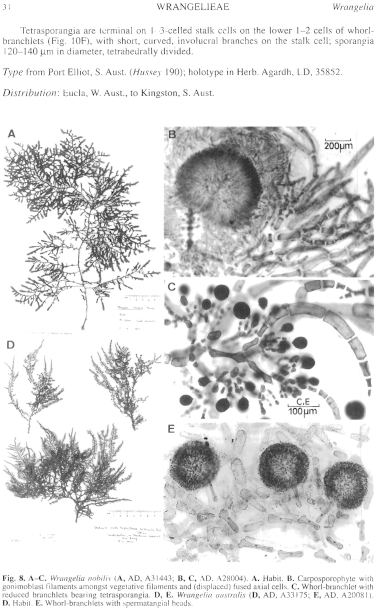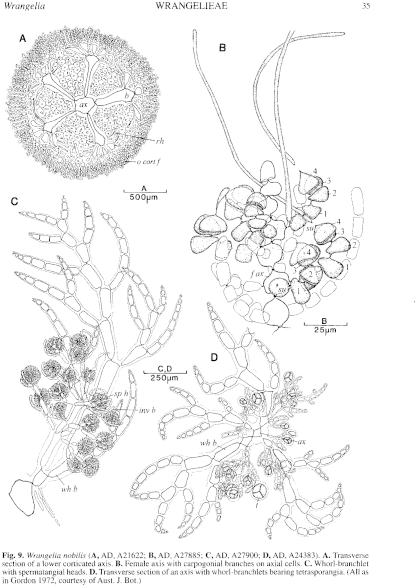|
|
|
|
|
|||||||||||
|
Electronic Flora of South Australia Species Fact Sheet
Phylum Rhodophyta – Order Ceramiales – Family Ceramiaceae – Tribe Wrangelieae
Selected citations: J. Agardh 1852: 709; 1876: 622. De Toni 1897: 133. Gordon 1972: 29, figs 7, 8, 53, 54A. Guiler 1952: 99. Harvey 1859b: 308; 1863, synop.: xxvii. Kützing 1849: 665. Lucas 1909: 23; 1929a: 16. Lucas & Perrin 1947: 141, fig. 14. May 1965: 366. Sonder 1853: 691; 1881: 29. Tisdall 1898: 511. Wilson 1892: 170.
Synonyms
Wrangelia jeanneretii Hooker & Harvey 1847: 411. J. Agardh 1852: 709; 1876: 624. De Toni 1897: 129. Guiler 1952; 99. Harvey 1859b: 308; 1863, synop.: xxvii. Kützing 1849: 665. Lucas 1909: 23; 1929a: 16. May 1965: 366. Sonder 1881: 29. Wrangelia comosa sensu Kützing 1849: 664 (in part); 1862: 13, pl. 41a-d.
Wrangelia dasyclada Harvey ex Kützing 1849: 664; 1862: 13, pl. 41e, f. J. Agardh 1852: 710; 1876: 625.
Wrangelia clavigera Harvey 1863: pl. 287, synop.: xxvii. J. Agardh 1876: 621; 1894a: 138, pl. 2 figs 8–11. Bornet & Thuret 1876: 184. De Toni 1897: 132; 1924: 149. Lucas 1909: 23; 1929b: 48. Lucas & Perrin 1947: 140, fig. 13. May 1965: 366. Mazza 1919: No. 677. Reinbold 1897: 46. Sonder 1881: 29. Tisdall 1898: 511. Wilson 1892: 170. Womersley 1950: 180.
Wrangelia ballioides J. Agardh 1876: 621. De Toni 1897: 132. Guiler 1952: 99. Lucas 1909: 23; 1929a: 16. Lucas & Perrin 1947: 141, fig. 15. May 1965: 366. Sonder 1881: 29. Tisdall 1898: 511. Wilson 1892: 170.
Griffithsia radiciformis Hooker & Harvey 1847: 411.
Thallus (Fig. 8A) medium to dark red-brown, 10–35 cm high, alternately distichously branched for 3–4 orders, lateral branches spreading, unequal, often with flattened clavate ends, covered with overlapping whorl-branchlets. Holdfast discoid, 4–12 mm across, composed of entwined rhizoids from the axis; epilithic. Structure. Axes with small apical cells dividing more or less transversely, increasing in size to 300–400 in diameter and 800–1000 µm long below, subapical cells cutting off first two opposite periaxial cells then three more, with the third and fifth on the same side giving a dorsiventral arrangement and the first and second developing into larger whorl-branchlets producing a flattened branch; mature lateral whorl-branchlets 2–3 mm long, alternately pinnate, tapering to acute terminal cells, mid cells 55–90 µm in diameter and L/D (1–) 2–5 (–10). Indeterminate branches arising on the basal cell of lateral whorl-branchlets. Branches densely corticated (Fig. 9A) by descending rhizoids from the basal cells of whorl-branchlets, forming outwardly a thick mat of short, simple or furcate, branchlets; lower parts of branches becoming denuded of whorl-branchlets. Cells uninucleate; rhodoplasts discoid, in chains in larger cells.
Reproduction: Gametophytes dioecious. Procarps (Fig. 9B) formed on axial cells near apices, usually 2 per axial cell; carpogonial branches 4-celled with each cell cutting off a small cell and a connecting cell between the fertilized carpogonium and the auxiliary cell. Post-fertilization stages as in W. plumosa with sterile whorl-branchlets intermixed with the carposporophyte (Fig. 8B) which bears clavate carposporangia, the whole subspherical and 560–800 (–1000) µm across. Spermatangial heads (Fig. 9C) subspherical, 70–100 µm in diameter, borne on reduced whorl-branchlets with short (2 or 3 small-celled) involucral branches from each stalk cell.
Tetrasporangia terminal on cells of short, small-celled, laterals (Fig. 9D) on the basal cells of whorl-branchlets (Fig. 8C), 65–100 µm in diameter, tetrahedrally divided.
Type from Georgetown, Tas. (Gunn); lectotype (Gunn 1324) in BM.
Selected specimens: 4 km W of Waldegrave I., S. Aust., 30 m deep (Branden, 3.vii.1987; AD, A57593). Elliston, S. Aust., 6 m deep (Shepherd, 24.x.1969; AD, A34883). Pearson I., S. Aust., 12 m deep (Turner, 27.iii.1982; AD, A53075). Between Hopkins and Thistle Is, S. Aust., 6–10 m deep (Baldock, 1.i.1964; AD, A27108). Port Elliot, S. Aust., drift (Parsons, 3.xi.1967; AD, A31443) and (Womersley, 21.vi.1964; AD, A28004). Pennington Bay, Kangaroo I., S. Aust., sublittoral fringe (Gordon, 17.xi.1967; AD, A31449). Young Rocks, S of Kangaroo I., S. Aust., 16–30 m deep (Branden, 18.vi.1991; AD, A61442). Cape Thomas, S. Aust., drift (Womersley, 24.viii.1960; AD, A24383). Robe, S. Aust., drift (Gordon, 18.v.1964; AD, A27900). Stinky Bay, Nora Creina, S. Aust., drift (Wollaston, 19.v.1964; AD, A27885). Double Corner Beach, Portland, Vic., drift (Beauglehole, 22.vi.1952; AD, A21622). Walkerville, Vic., drift (SinkoraA2370,17.iii.1977; AD, A48370). Low Head, Tas., drift (Perrin, 8.x.1950; AD, A16415). Satellite I., D'Entrecasteaux Channel, Tas., 10 m deep (Shepherd, 18.ii.1972; AD, A41696).
Distribution: Waldegrave I., S. Aust., to Walkerville, Vic., and around Tasmania.
References:
AGARDH, J.G. (1852). Species Genera et Ordines Algarum. Vol. 2, Part 2, pp. 337–720. (Gleerup: Lund.)
AGARDH, J.G. (1876). Species Genera et Ordines Algarum. Vol. 3, Part 1- Epicrisis systematic Floridearum, pp. i-vii, 1–724. (Weigel: Leipzig.)
AGARDH, J.G. (1894a). Analecta Algologica. Cont. I. Acta Univ. lund. 29, 1–144, Plates 1, 2.
BORNET, E. & THURET, G. (1876). Notes Algologiques. Fasc. 1, pp. 1–70, Plates 1–25. (Masson: Paris.)
DE TONI, G.B. (1897). Sylloge Algarum omnium hucusque Cognitarum. Vol. 4. Florideae. Sect. 1, pp. 1–388. (Padua.)
DE TONI, G.B. (1924). Sylloge Algarum omnium hucusque Cognitarum. Vol. 6. Florideae. (Padua.)
GORDON, E.M. (1972). Comparative morphology and taxonomy of the Wrangelieae, Sphondylothamnieae and Spermothamnieae (Ceramiaceae, Rhodophyta). Aust. J. Bot. suppl. 4, 1–180.
GUILER, E.R. (1952). The marine algae of Tasmania. Checklist with localities. Pap. Proc. R. Soc. Tasmania 86, 71–106.
HARVEY, W.H. (1859b). Algae. In Hooker, J.D., The Botany of the Antarctic Voyage. III. Flora Tasmaniae. Vol. II, pp. 282–343, Plates 185–196. (Reeve: London.)
HARVEY, W.H. (1863). Phycologia Australica. Vol. 5, Plates 241–300, synop., pp. i-lxxiii. (Reeve: London.)
HOOKER, J.D. & HARVEY, W.H. (1847). Algae Tasmanicae. Lond. J. Bot. 6, 397–417.
KÜTZING, F.T. (1849). Species Algarum. (Leipzig.)
KÜTZING, F.T. (1862). Tabulae Phycologicae. Vol 12. (Nordhausen.)
LUCAS, A.H.S. & PERRIN, F. (1947). The Seaweeds of South Australia. Part 2. The Red Seaweeds. (Govt Printer: Adelaide.)
LUCAS, A.H.S. (1909). Revised list of the Fucoideae and Florideae of Australia. Proc. Linn. Soc. N.S.W. 34, 9–60.
LUCAS, A.H.S. (1929a). The marine algae of Tasmania. Pap. Proc. R. Soc. Tasm. 1928, 6–27.
LUCAS, A.H.S. (1929b). A census of the marine algae of South Australia. Trans. R. Soc. S. Aust. 53, 45–53.
MAY, V. (1965). A census and key to the species of Rhodophyceae (red algae) recorded from Australia. Contr. N.S.W. natn. Herb. 3, 349–429.
MAZZA, A. (1919). Aggiunte al Saggio di Algologia Oceanica. (Florideae). Nuova Notarisia 30, Nos. 661–683.
REINBOLD, T. (1897). Die Algen der Lacepede und Guichen Bay und deren näherer Umgebung (Süd Australien), gesammelt von Dr. A. Engelhart-Kingston. Nuova Notarisia 8, 41–62.
SONDER, O.W. (1853). Plantae Muellerianae. Algae. Linnaea 25, 657–709.
SONDER, O.W. (1881). In Mueller, F., Fragmenta Phytographiae Australiae. Supplementum ad volumen undecinum: Algae Australianae hactenus cognitae, pp. 1–42, 105–107. (Melbourne.)
TISDALL, H.T. (1898). The algae of Victoria. Rep. 7th Meet. Aust. Ass. Adv. Sci., Sydney, 1898, pp. 493–516.
WILSON, J.B. (1892). Catalogue of algae collected at or near Port Phillip Heads and Western Port. Proc. R. Soc. Vict. 4, 157–190.
WOMERSLEY, H.B.S. (1950). The marine algae of Kangaroo Island. III. List of Species 1. Trans. R. Soc. S. Aust. 73, 137–197.
The Marine Benthic Flora of Southern Australia Part IIIC complete list of references.
Publication:
Womersley, H.B.S. (24 December, 1998)
The Marine Benthic Flora of Southern Australia
Rhodophyta. Part IIIC. Ceramiales – Ceramiaceae, Dasyaceae
©State Herbarium of South Australia, Government of South Australia
Illustrations in Womersley Part IIIA, 1998: FIGS 8 A–C, 9.

Figure 8 enlarge
Fig. 8. A–C. Wrangelia nobilis (A, AD, A31443; B, C, AD, A28004). A. Habit. B. Carposporophyte with gonimoblast filaments amongst vegetative filaments and (displaced) fused axial cells. C. Whorl-branchlet with reduced branchlets bearing tetrasporangia. D, E. Wrangelia australis (D, AD, A33175; E, AD, A20081). D. Habit. E. Whorl-branchlets with spermatangial heads.

Figure 9 enlarge
Fig. 9. Wrangelia nobilis (A, AD, A21622; B, AD, A27885; C, AD, A27900; D, AD, A24383). A. Transverse section of a lower corticated axis. B. Female axis with carpogonial branches on axial cells. C. Whorl-branchlet with spermatangial heads. D. Transverse section of an axis with whorl-branchlets bearing tetrasporangia. (All as in Gordon 1972, courtesy of Aust. J. Bot.)

|
Email Contact: State Herbarium of South Australia |

|